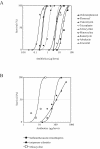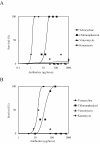Quantitative evaluation of the therapeutic effects of antibiotics using silkworms infected with human pathogenic microorganisms
- PMID: 14982763
- PMCID: PMC353159
- DOI: 10.1128/AAC.48.3.774-779.2004
Quantitative evaluation of the therapeutic effects of antibiotics using silkworms infected with human pathogenic microorganisms
Abstract
The injection of bacteria (Staphylococcus aureus, Stenotrophomonas maltophilia) or true fungi (Candida albicans, Candida tropicalis) that are pathogenic to humans into the silkworm hemolymph leads to death of the larvae within 2 days. Antibiotics used for clinical purposes have therapeutic effects on silkworms infected with these pathogens. The 50% effective doses obtained by injection into the silkworm hemolymph are consistent with those reported for mice. Injection of vancomycin and kanamycin into the silkworm hemolymph was effective, but oral administration was not. Chloramphenicol, which is effective by oral administration, appeared in the silkworm hemolymph soon after injection into the midgut, whereas vancomycin did not. Isolated midgut membranes were impermeable to vancomycin. Thus, the ineffectiveness of oral administration of vancomycin to silkworms is due to a lack of intestinal absorption.
Figures





References
-
- Akimitsu, N., H. Hamamoto, R. Inoue, M. Shoji, A. Akamine, K. Takemori, N. Hamasaki, and K. Sekimizu. 1999. Increase in resistance of methicillin-resistant Staphylococcus aureus to beta-lactams caused by mutations conferring resistance to benzalkonium chloride, a disinfectant widely used in hospitals. Antimicrob. Agents Chemother. 43:3042-3043. - PMC - PubMed
-
- Ates, O., A. Gursoy, H. Altintas, G. Otuk, and S. Birteksoz. 2003. Synthesis and antimicrobial activity of {2-[2-(N,N-disubstituted thiocarbamoyl-sulfanyl)-acylamino] thiazol-4-yl} acetic acid ethyl esters. Arch. Pharm. (Weinheim) 336:39-46. - PubMed
-
- Ford, C. W., J. C. Hamel, D. M. Wilson, J. K. Moerman, D. Stapert, R. J. Yancey, Jr., D. K. Hutchinson, M. R. Barbachyn, and S. J. Brickner. 1996. In vivo activities of U-100592 and U-100766, novel oxazolidinone antimicrobial agents, against experimental bacterial infections. Antimicrob. Agents Chemother. 40:1508-1513. - PMC - PubMed
Publication types
MeSH terms
Substances
LinkOut - more resources
Full Text Sources
Other Literature Sources
Medical

